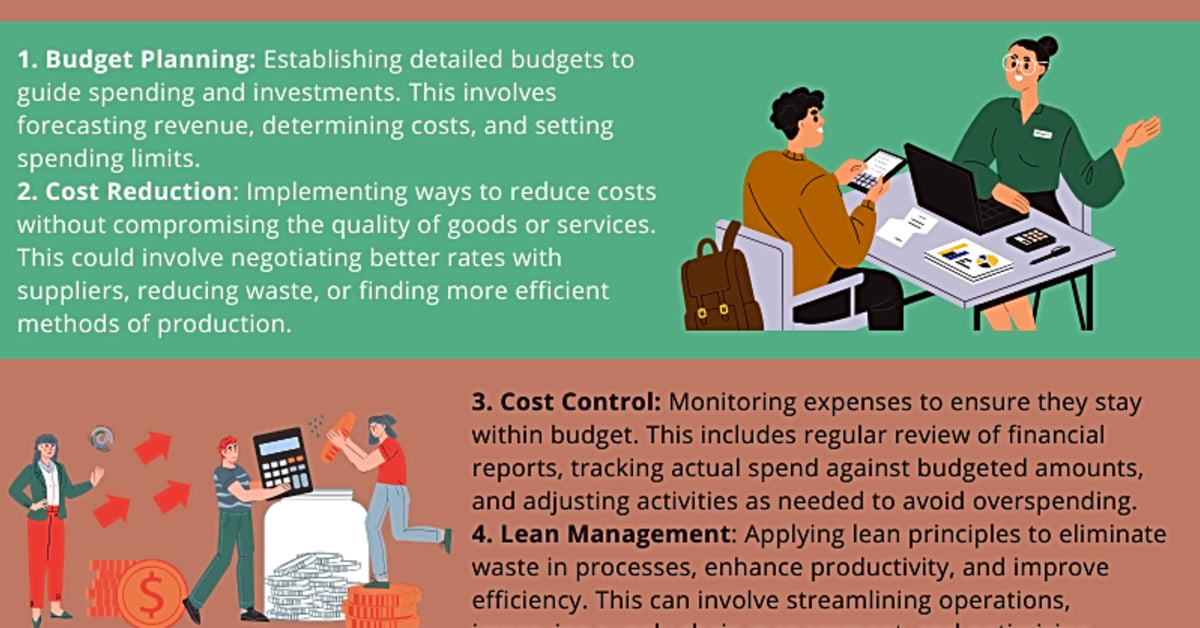Strategies for Cutting Costs and Improving Business Performance
 by Consultant
by Consultant

Are you looking for ways to improve your business performance while also cutting costs? If so, you’re in the right place. In today’s competitive market, businesses are constantly looking for ways to streamline their operations and reduce expenses. This is where cost-cutting measures come into play. By implementing effective strategies, businesses can not only save money but also boost their overall performance. In this article, we’ll explore various cost-cutting measures that can help you achieve your financial goals and improve your business’s success. Whether you’re a small startup or a large corporation, these strategies can be applied to any type of business. So, let’s dive in and discover the best ways to cut costs and boost your bottom line.In today’s competitive business landscape, companies are constantly seeking ways to improve their performance and stay ahead of the game. One effective approach is to implement cost-cutting measures, which can not only reduce expenses but also help businesses become more efficient and profitable. In this article, we will explore various strategies for cutting costs and achieving better business results. Firstly, we will delve into the importance of strategic planning and how it can lay the foundation for effective cost-cutting measures. Strategic planning is crucial for any business as it helps to identify areas for improvement and set clear goals and objectives. By defining organizational goals, businesses can align their cost-cutting efforts with their overall vision and ensure that they are moving in the right direction.One key element of a solid strategic plan is conducting a SWOT analysis. This involves identifying the strengths, weaknesses, opportunities, and threats facing a business. By understanding these factors, businesses can prioritize their cost-cutting efforts and focus on areas where they have a competitive advantage or potential for improvement. A SWOT analysis also helps to identify potential risks and challenges that may arise during the implementation of cost-cutting measures.Another important aspect of strategic planning is defining clear objectives. This involves setting specific, measurable, achievable, relevant, and time-bound (SMART) goals for cost reduction. By setting clear objectives, businesses can track their progress and make necessary adjustments to their cost-cutting strategies if needed.Moving on to different types of business strategies, lean management is a popular approach that focuses on eliminating waste and improving efficiency. By streamlining processes and reducing unnecessary expenses, businesses can achieve significant cost savings while maintaining or even improving the quality of their products or services.Process optimization is another strategy that can help businesses cut costs. By analyzing and improving internal processes, businesses can identify inefficiencies and eliminate unnecessary steps or resources. This not only reduces expenses but also leads to improved productivity and customer satisfaction.Outsourcing is also a common cost-cutting strategy, where businesses delegate certain tasks or functions to external vendors. This can help businesses save on labor and operational costs, as well as access specialized expertise that may not be available in-house.In addition to these business strategies, financial strategies such as budgeting and cost control are essential for managing expenses. Budgeting involves creating a plan for allocating resources and setting limits for expenses. By closely monitoring and controlling expenses, businesses can prevent overspending and identify areas where costs can be reduced.Cost control involves regularly reviewing and analyzing expenses to identify areas for improvement. This can include negotiating better deals with suppliers, finding more cost-effective alternatives, or implementing process improvements to reduce costs.To put these strategies into perspective, let’s take a look at a real-life example. A manufacturing company was facing increasing competition and declining profits. After conducting a SWOT analysis, the company identified that their production process was inefficient and was leading to high operational costs. By implementing lean management principles and optimizing their production process, the company was able to reduce costs by 20% and improve their bottom line.In conclusion, strategic planning is crucial for laying the foundation for effective cost-cutting measures. By defining clear goals and objectives, conducting a SWOT analysis, and identifying areas for improvement, businesses can align their cost-cutting efforts with their overall vision and achieve better results. By utilizing various business strategies such as lean management, process optimization, and outsourcing, as well as financial strategies like budgeting and cost control, businesses can reduce expenses while improving their efficiency and profitability.
Understanding Strategic Analysis
In today’s competitive business landscape, it is crucial for companies to regularly conduct strategic analysis to identify areas for cost savings. Strategic analysis involves evaluating a company’s internal and external environment to gain insights into its strengths, weaknesses, opportunities, and threats. By understanding these factors, businesses can make informed decisions on where to cut costs without compromising their overall performance.
Exploring Different Business Strategies
In today’s competitive business landscape, companies are constantly seeking ways to improve their performance and stay ahead of the game. One effective approach is to implement cost-cutting measures, which can not only reduce expenses but also help businesses become more efficient and profitable. However, it is important for businesses to carefully consider which strategies will work best for their specific needs and goals. In this article, we will explore a range of business strategies that can help you cut costs and improve efficiency.
Financial Strategies for Cost Control
In today’s fast-paced and competitive business landscape, companies are constantly seeking ways to improve their performance and stay ahead of the game. One effective approach is to implement cost-cutting measures, which can not only reduce expenses but also help businesses become more efficient and profitable. However, simply cutting costs without a proper financial strategy in place can lead to negative consequences in the long run.
To effectively manage expenses, companies should consider incorporating financial strategies that can help them control costs without sacrificing quality or hindering growth. These strategies can provide valuable insights into areas where expenses can be reduced and where investments should be made for maximum return.
One financial strategy for cost control is conducting regular budget reviews and analysis. By consistently monitoring expenses and identifying areas where costs can be trimmed, businesses can make necessary adjustments to their budget and maintain a healthy financial standing.
Another helpful strategy is implementing smart spending policies. This can include negotiating with vendors for better deals, using technology to streamline processes and reduce labor costs, and encouraging employees to be mindful of their spending habits.
Furthermore, companies can also benefit from implementing a cost allocation system. This involves assigning specific costs to different departments or projects, allowing for better tracking and control over expenses.
Overall, incorporating financial strategies for cost control can provide businesses with valuable insights on managing expenses and making strategic investments for improved business performance. By carefully considering these strategies and implementing them effectively, companies can achieve better financial stability and success in the long run.
In conclusion, implementing effective cost-cutting measures is essential for businesses looking to enhance their overall performance. By incorporating strategic planning, analyzing different business strategies, and adopting sound financial practices, companies can achieve significant cost savings and boost their bottom line. It is crucial for businesses to regularly review their cost-cutting strategies and adapt them to changing market conditions to stay competitive and achieve long-term success.
About The Author
Related Posts
Learn about strategic planning, organizational strategy, and more to enhance your business strategy.